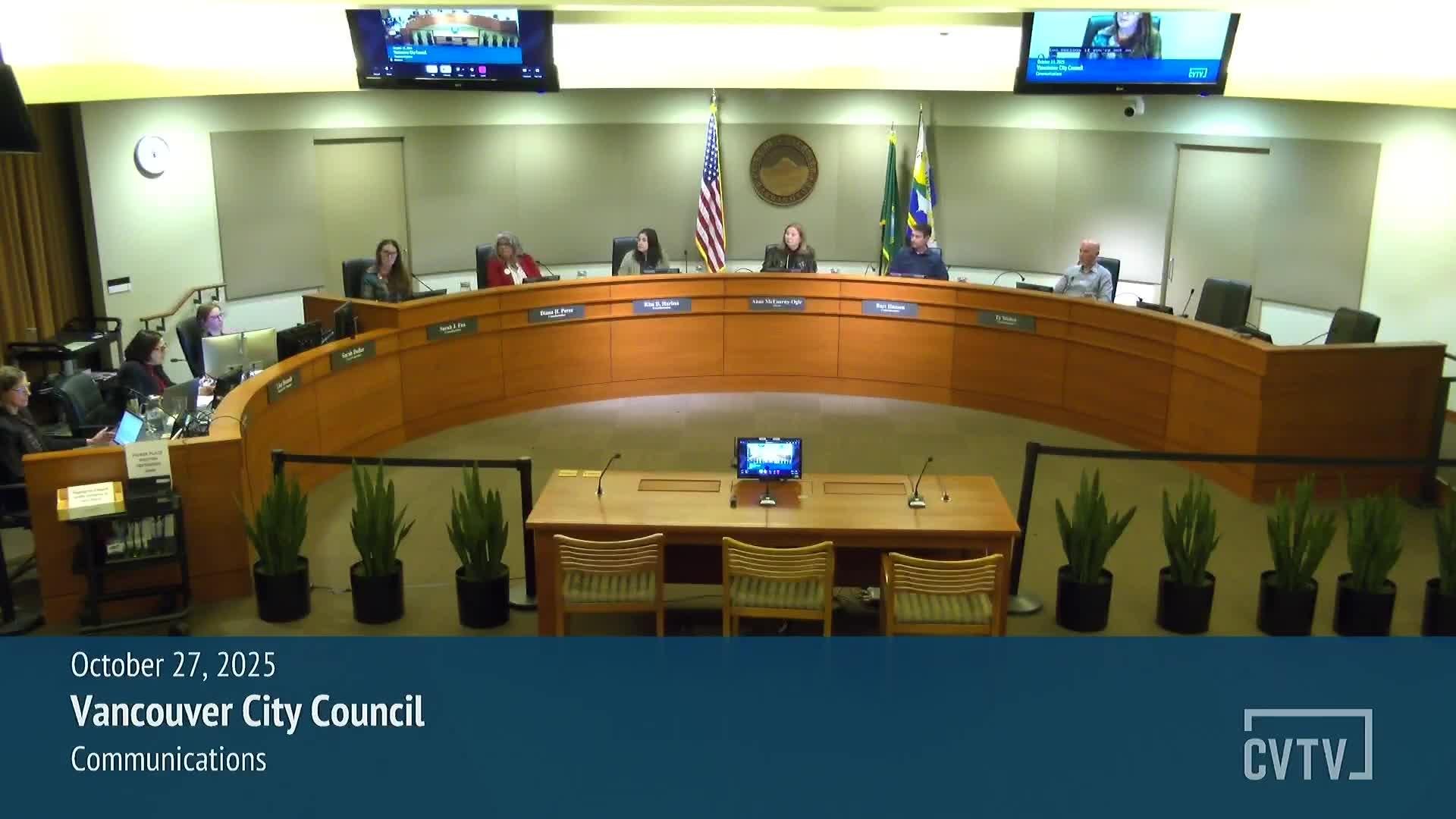Workforce Southwest Washington urges Vancouver to align on apprenticeships, childcare and quality jobs
October 27, 2025 | Vancouver, Clark County, Washington
This article was created by AI summarizing key points discussed. AI makes mistakes, so for full details and context, please refer to the video of the full meeting. Please report any errors so we can fix them. Report an error »

Vancouver City Council members heard a presentation Oct. 27 from Workforce Southwest Washington outlining how the city can align its Comprehensive Economic Development Strategy with regional workforce initiatives to expand access to quality jobs.
"We want to make sure that our partnership continues to grow," said Marnie Farnes, director of programs at Workforce Southwest Washington, noting WSW�92s role as the WIOA-designated workforce board for Clark, Cowlitz and Wahkiakum counties. Farnes said WSW funds training and supportive services through WorkSource centers and partners with business, higher education and labor to connect workers to careers in advanced manufacturing, health care and construction.
The presentation listed four core goals: establish pathways to accessible, quality jobs; advance equity and diversity in the construction trades; improve retention of apprentices and workers; and connect career changers to training and jobs. Farnes highlighted pre-apprenticeship and youth programs, noting the region�92s summer internship efforts for youth ages 16�9224 and large career fairs such as Dozer Day and a Grade 13 hiring event for construction CTE students.
"Pre-apprenticeship programs in the building trades are one of the only proven effective strategies at truly being able to engage women and people of color in construction jobs," Farnes said, and called for stronger reporting mechanisms, zero-tolerance job-site policies and consistent implementation of job-site culture programs to improve retention.
WSW also asked the city to consider investment tools that favor employers who provide higher wages, predictable schedules and career advancement, citing a Port of Portland industrial-park model that set employer criteria tied to quality jobs. The agency noted long-standing partnership work with the Columbia River Economic Development Council and recommended coordinated recruitment of traded-sector employers that typically offer higher pay and benefits.
Child care was another focal point. Darcy Hoffman, director of business services for WSW, said the agency�92s 2020 "business case for child care" survey found one in five workers reported childcare issues that impeded attendance, and that employers and public partners can co-design options such as on-site care, subsidies and scheduling flexibility. WSW cited Oregon�92s employee-related day care fund as an example of a subsidy model for apprentices on highway projects.
WSW offered specific partnership options: city financial or in-kind investment in training and job fairs, participation on advisory boards and use of city communications channels to promote programs. Councilors responded positively and asked for follow-up on youth programming and potential grant partnerships.
"We're barely scratching the surface today," Farnes said, urging continued coordination so WSW and the city can jointly pursue regional grants and align strategies.
The presentation concluded with an offer to follow up on specific collaborations and to provide further documentation linking WSW programs to the city's five-year economic strategy.
"We want to make sure that our partnership continues to grow," said Marnie Farnes, director of programs at Workforce Southwest Washington, noting WSW�92s role as the WIOA-designated workforce board for Clark, Cowlitz and Wahkiakum counties. Farnes said WSW funds training and supportive services through WorkSource centers and partners with business, higher education and labor to connect workers to careers in advanced manufacturing, health care and construction.
The presentation listed four core goals: establish pathways to accessible, quality jobs; advance equity and diversity in the construction trades; improve retention of apprentices and workers; and connect career changers to training and jobs. Farnes highlighted pre-apprenticeship and youth programs, noting the region�92s summer internship efforts for youth ages 16�9224 and large career fairs such as Dozer Day and a Grade 13 hiring event for construction CTE students.
"Pre-apprenticeship programs in the building trades are one of the only proven effective strategies at truly being able to engage women and people of color in construction jobs," Farnes said, and called for stronger reporting mechanisms, zero-tolerance job-site policies and consistent implementation of job-site culture programs to improve retention.
WSW also asked the city to consider investment tools that favor employers who provide higher wages, predictable schedules and career advancement, citing a Port of Portland industrial-park model that set employer criteria tied to quality jobs. The agency noted long-standing partnership work with the Columbia River Economic Development Council and recommended coordinated recruitment of traded-sector employers that typically offer higher pay and benefits.
Child care was another focal point. Darcy Hoffman, director of business services for WSW, said the agency�92s 2020 "business case for child care" survey found one in five workers reported childcare issues that impeded attendance, and that employers and public partners can co-design options such as on-site care, subsidies and scheduling flexibility. WSW cited Oregon�92s employee-related day care fund as an example of a subsidy model for apprentices on highway projects.
WSW offered specific partnership options: city financial or in-kind investment in training and job fairs, participation on advisory boards and use of city communications channels to promote programs. Councilors responded positively and asked for follow-up on youth programming and potential grant partnerships.
"We're barely scratching the surface today," Farnes said, urging continued coordination so WSW and the city can jointly pursue regional grants and align strategies.
The presentation concluded with an offer to follow up on specific collaborations and to provide further documentation linking WSW programs to the city's five-year economic strategy.
View full meeting
This article is based on a recent meeting—watch the full video and explore the complete transcript for deeper insights into the discussion.
View full meeting
